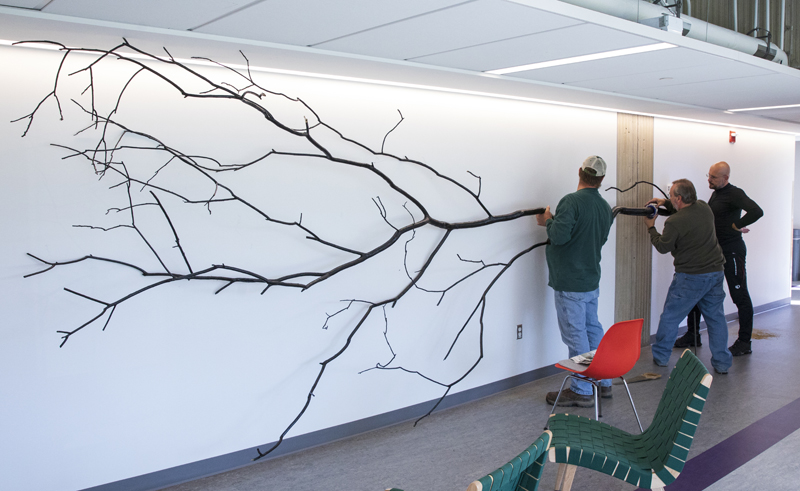Psychology, art departments partner on Science 4 project
New visuals feature brain-shaped window clings, dendritic tree

How many brains does it take to label a psychology department?
Blazo Kovacevic will let you know when he’s done printing them out.
“Really, those little things on our way to work or school are opportunities for us to be not glued to the screen, but immersed in something bigger than us,” Kovacevic said. “In the sense of architectural forms, something that promotes that kind of retrospective thinking is these brains.”
Kovacevic, an associate professor in the Department of Art and Design, has been installing brain-shaped window clings on the newly renovated Science 4 building. The brains are part of a larger project between the art and psychology departments that Kovacevic is working on. Ultimately, he’s responsible for developing signage and art to complement the building.
“We recently had the east half of Science 4 renovated,” said Matthew Johnson, chair of the Psychology Department. “We moved in this summer and as we were moving in we learned that we, as a department, were going to be putting up our own signage, the directory and all of the art.”
Instead of contracting an outside firm, Johnson brought the project to Kovacevic. With an eye for architecture and a mind bubbling with new ideas, Kovacevic was happy to take on the challenge.
“I went into the planning and research thinking about what would be meaningful, but not a repetition of something that already exists,” Kovacevic explained.
Building from the department’s research, Kovacevic visualized what it means to study psychology.
“We met and walked the building together and I went through some of the research that my colleagues are doing here in the department.” Johnson said. “He thought images of the brain would match well with the building and with the campus. He thought that would dovetail well with the overall aesthetics of campus, the building and the research that we do in the department.”
Fixating on the core values of psychology, Kovacevic found inspiration in the structures of the brain.
“No matter what you study in psychology, the brain is going to be involved, and I think he picked up on that,” Johnson said. “All of us are in some way studying the brain and he took that concept and ran with it.”
After drafting mock-ups, Kovacevic began his first art instillation within the building: a dendritic tree.
“I found this tree in that forest right there,” Kovacevic said, pointing outside of Science 4. “I dragged it into the sculpture department to strip the bark and preserve it, keeping what’s beautiful about this tree.”
After conceptualizing the art piece with the Psychology Department, Kovacevic consulted University environmental officials to ensure that he wouldn’t be disrupting the campus ecosystem. Once he received approval, he began navigating a variety of safety measures.
“It’s worth mentioning that Physical Facilities has been the third partner,” Johnson said. “You don’t put a tree on a wall without a lot of help.”
Kovacevic hoped to provoke introspection and connection, mounting the tree in front of the second-floor lounge.
“The idea here is to have a neuron-like environment,” Kovacevic said. “It’s obviously not a model of one, but it connects to something we’re familiar with – the tree.”
Though the art is more than a clinical model, it’s all rooted in science. Kovacevic worked with Gökhan Ersan to develop the concepts and designs, and later worked with Professor Patricia Di Lorenzo to ensure his tree remained accurate, focusing on the details to marry his artistic vision with facts.
“We struggle, but in a good way. She wants this to be accurate as much as possible, but we want it to be visually pleasing as well,” Kovacevic said. “I see that as a clash, but not as a negative thing. Conflict is not negative, it’s natural.”
Along with the dendritic tree, Kovacevic is installing more of the brain-shaped window clings that will glow in the dark.
“It’s not to obscure, but to have something in the windows that will label this building,” Kovacevic said. “I want to show that this is, more than anything, a research-driven Psychology Department.”
Translating the research that happens within Science 4 to the exterior has been a challenge that has motivated Kovacevic throughout this project.
“Right now I’m afraid that if you visited Binghamton University, you wouldn’t know,” Kovacevic said. “There’s so much richness and prestige inside, but outside there is none of that, and we need to change and reflect on that. If we are a good department with great results, the outside should project that success.”
The project is altering the atmosphere of the building, playing with the perspectives of the students who do research there.
“It’s already started conversations. As I walk by the dendritic tree, or as I walk by the pictures of the brains, I hear people talking about it, and that’s wonderful,” Johnson said. “Whether they like it or dislike it is in some ways less important. It’s been fun to see people talk and think about it.”
Stirring up conversations and inciting new questions, Kovacevic is excited to see what people make of his art.
“I believe in building good problems that are not inhibiting, but directing. Through problem solving you get somewhere else, to another place,” Kovacevic explained. “This is also part of the educational process. If this surprises anybody in a good way, then it is successful and valuable and needed.”

